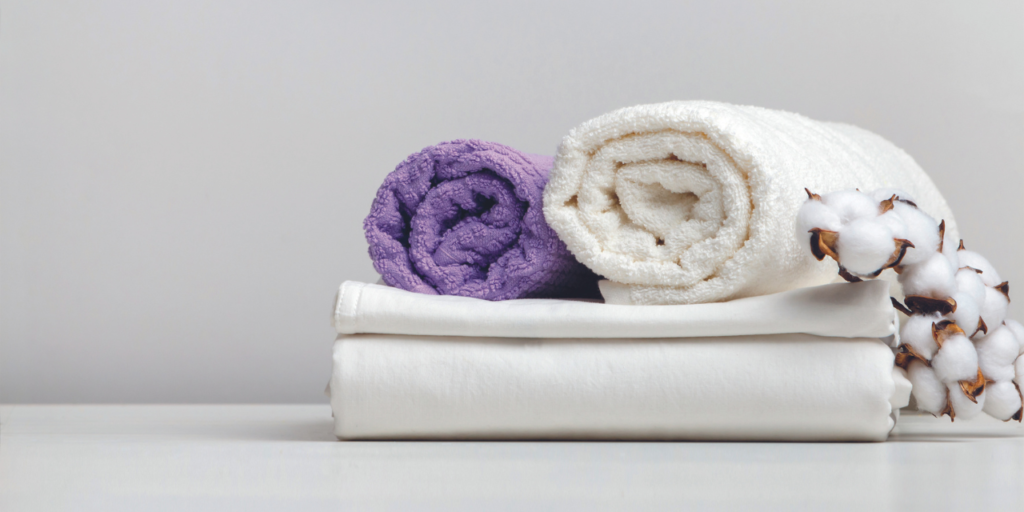
Home textiles are often susceptible to bacterial growth, and this is largely because the moist and warm environments in our kitchens, bathrooms, and bedrooms tick every box for rapid microbial proliferation. Unfortunately, even if household linens like sheets and towels are laundered on a regular basis, these problems will persist, and there are items such as mattresses and rugs that can’t be washed at all, highlighting the need for a more proactive approach. This article outlines the issues that bacterial growth can cause in a household and talks about how antimicrobial technology can be incorporated into fabrics to keep them clean and fresh for longer.
Textiles can be found everywhere in our homes; they are in the towels in our kitchens, the shower curtains in our bathrooms, the cushions in our living rooms, and the linen on our beds. Unfortunately, that means so are microbes. These small unseen microorganisms thrive in warm and humid environments created when we wash our dishes, take showers and sleep, and, if they’re not kept in check, they can grow into large colonies and cause harm to the fabric. Mould and mildew can create nasty stains and unpleasant odours while certain bacteria can lead to the development of allergens1. They can multiply in the fibres of our textiles and, in doing so, they compromise the cleanliness of everyday items that contribute to aesthetics and comfort.
Kitchens
Kitchens are rich with high-touch surfaces that are regularly contaminated through human contact and food residues. Commonly used items such as sponges and dish towels are constantly in contact with contaminants and, as they are rarely given the opportunity to dry out, they are highly susceptible to microbial growth. In a 2014 study examining 82 dish towels, the findings revealed an average of 3.16×108 colony-forming units (CFU) per towel2, surpassing the microbial count observed on the floor of a fast-food restaurant restroom.
Bathrooms
Similar to kitchens, bathrooms have high levels of humidity which, coupled with toilet plumes and darkness, creates a perfect breeding ground for microbes. A shower curtain can have as much as 69 times more bacteria than toilet seats3, not to mention the towels that absorb moisture and collect skin cells.
Bedrooms
Recommendations suggest that sheets and other bedding should be washed every seven days as they are daily contaminated with sweat and skin cells but, in reality, there are often 24 days in between washes in an average household4. Bulkier items – such as blankets, pillows, and mattress pads – are washed even less frequently, while mattresses, rugs, and upholstery usually don’t get cleaned at all. This allows bacteria to get a firm foothold in bedroom textiles, creating smells, and stains, and reducing the lifetime of the items.
Antimicrobial technology to the rescue
The incorporation of antimicrobial technology into textiles is a welcome solution to this microbial challenge, offering a proactive defence against the unseen threats that lurk in our towels, shower curtains, and bed linens. This innovative approach not only preserves the integrity and longevity of textiles but also contributes to a more pleasant living environment by minimising the risk of stains and odours associated with microbial growth. These technologies can be integrated into the fabric’s composition, offering resilient and efficient surface protection. When used in tandem with traditional laundering practices, they serve as a complementary method to shield surfaces, thereby contributing to the prolonged durability of nonwoven fabrics.
Microban stands at the forefront of antimicrobial and odour control technologies, boasting extensive expertise in collaborating with global brands and manufacturers to create nonwoven materials with integrated antimicrobial product protection, including towels, mattresses, bedsheets, and bath accessories. The company presents an impressive array of EPA-registered and BPR-adherent technologies, including metal-free chemistries. These technologies can be seamlessly incorporated into materials during the manufacturing process, ensuring a smooth product enhancement without compromising the inherent qualities of the fabrics.
Summary
Home textiles, such as sheets and towels, frequently fall prey to bacterial growth due to the ideal warm and moist conditions found in kitchens, bathrooms, and bedrooms. Even with regular laundering, issues remain, especially for items like mattresses and rugs that cannot be easily washed. This challenge can be addressed by incorporating antimicrobial technology, providing a proactive 24/7 defence against unseen organisms present. Antimicrobial product enhancement maintains the quality and lifespan of textiles and keeps the fabrics cleaner between cleans, enhancing the feeling of freshness in your home.
References
- Nordengrün, M, Michalik, S, Völker, U, Bröker, BM & Gómez-Gascón, L, 2018, ‘The quest for bacterial allergens’, International Journal of Medical Microbiology, vol. 308, no. 6, pp. 738-750.
- Gerba, CP, Tamimi, AH, Maxwell, S, Sifuentes, LY, Hoffman, DR & Koenig, DW’, 2014, ‘Bacterial occurrence in kitchen hand towels’, Food Protection Trends, vol. 34, no. 5, pp. 312-317.
- SafeHome (2023). Bathroom Bacteria & Germs Statistics for 2023. Accessed 13 December 2023. https://www.safehome.org/resources/germs-in-your-bathroom/
- Everyday Health (2023). How Often Should You Wash Your Sheets? Accessed 13 December 2023. https://www.everydayhealth.com/healthy-living/how-often-should-you-wash-your-sheets/
